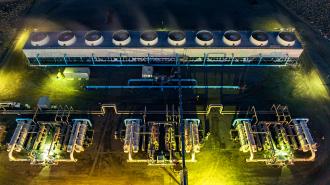A Google-backed startup has successfully tested an enhanced geothermal system that could harness Earth’s inner heat to generate clean electricity anywhere, anytime — and they built it, ironically, with technology perfected by the oil industry.
The challenge: Geothermal power plants take advantage of the heat radiating from deep inside the Earth to create electricity. Usually, this is done by drilling wells down to natural underground reservoirs of hot water and using that steam to spin electric turbines.
This is a clean, reliable source of energy, but it is hard to scale. The need to build geothermal plants near existing hydrothermal reservoirs, which are relatively rare, limits its use to a handful of places — today, geothermal supplies just 0.4% of the US’s utility-scale electricity.
The first enhanced geothermal systems were expensive to build and couldn’t generate enough power to be cost-effective.
The idea: Natural hydrothermal reservoirs aren’t common in most of the country, but if you drill down enough, you can find hot rock anywhere.
Enhanced geothermal systems are a way to tap into that heat. They’re made by using drilling and fracking techniques to inject fluid deep into the ground, pushing open tiny fractures in hot rock, creating new hydrothermal reservoirs wherever we want them.
While enhanced geothermal systems were first demonstrated in the 1970s, they were expensive to build and couldn’t generate enough power to be cost-effective, and construction has been known to trigger earthquakes — as a result, only a few commercial systems are operating today.
What’s new? Houston-based startup Fervo Energy is on a mission to unlock the potential of enhanced geothermal systems by using cutting-edge technologies used by the oil and gas industries to minimize safety risks and lower costs.
One of those technologies is horizontal drilling — where a drill goes down and then sideways. With a horizontal system, a single drilling location on the surface can tap into vastly more hot rock, and therefore generate more power, than the vertical wells that were tried in the 1970s.
In 2021, Fervo signed a deal with Google to build “Project Red,” a full-scale commercial pilot of an enhanced geothermal system in Nevada. It has now announced the successful completion of a 30-day test at the site.
“This is a very significant milestone in enhanced geothermal systems development.”
Wilson Ricks
The results: According to the company, the pilot test set two new records for an enhanced geothermal system, with a demonstrated flow rate of 63 liters per second and a power output of 3.5 MW, which is enough to support about 2,600 homes.
“This is a very significant milestone in enhanced geothermal systems development,” Wilson Ricks, a Princeton engineer who co-wrote a paper on geothermal energy along with Fervo researchers, told CNBC.
“It is the first application of the advanced drilling and well stimulation techniques developed in the shale oil and gas boom to geothermal, and has demonstrated that these can be used to create artificial geothermal reservoirs delivering high flow rates,” he continued.
Right direction: In 2022, the Department of Energy announced the Enhanced Geothermal Shot, a goal to slash the cost of enhanced geothermal systems by 90%, down to $45 per megawatt hour, by 2035.
Fervo CEO and co-founder Tim Latimer told Bloomberg the cost of generating electricity at Project Red is “significantly higher” than that, but he says that’s partly due to the pilot being a first-of-a-kind project and that he expects costs to “decline rapidly.”
“It’s not a ‘mid-century’ resource; it’s a ‘today’ resource.”
Tim Latimer
Looking ahead: Fervo plans to connect Project Red to the grid before the end of 2023 so that it can begin supplying geothermal power to Google data centers and infrastructure in Nevada.
The startup has already broken ground on another enhanced geothermal system in southwest Utah — that one is expected to join the grid in 2028 and generate 100 times more total power, enough electricity to power 300,000 homes.
“The significance of what we’ve done today is show that that technology actually will work a decade-plus ahead of where people thought we were on the tech roadmap,” Latimer told Bloomberg. “It’s not a ‘mid-century’ resource; it’s a ‘today’ resource.”
We’d love to hear from you! If you have a comment about this article or if you have a tip for a future Freethink story, please email us at [email protected].






